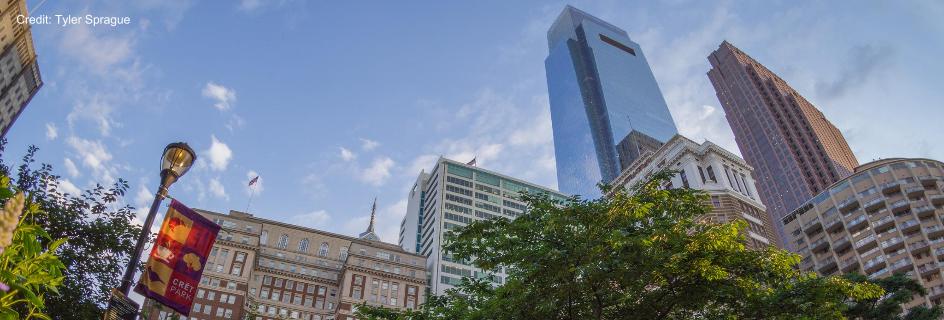- About GPA
- Global Events
- GLOBAL NEWS FROM PHL
- Global Directory
- World Heritage City
- Sustainable Development Goals (SDGs)
- Global Philadelphia Role on Sustainable Development Goals
- Completed Sustainable Development Goals
- SDG#1: No Poverty
- SDG #2: Zero Hunger
- SDG#3: Good Health & Well-Being
- SDG#4: Quality Education
- SDG#5: Gender Equality
- SDG#6: Clean Water & Sanitation
- SDG#7: Affordable and Clean Energy
- SDG #8: Decent Work and Economic Growth
- SDG #9: Industry, Innovation, and Infrastructure
- SDG#10: Reduced Inequalities
- SDG#11: Sustainable Cities and Communities
- SDG#16: Peace, Justice and Strong Institutions
- SDG#17: Partnerships for the Goals
- Press
Home ›
Mural Arts Program Hosts "Great Gateways and The Cities That Make Them" Panel
Posted on July 11, 2014

Related
Gabrielle Lantiere, for GPA -- On June 18 at the Philadelphia Center for Architecture, the City of Philadelphia Mural Arts Program (MAP) held a panel discussion titled “Great Gateways and the Cities That Make Them.” The panel featured an array of experts, ranging from a graffiti historian to Amtrak's chief of infrastructure investment and development.
The discussion focused on the innovative work of Katharina Grosse and the recent psychylustro project. The project consisted of seven large-scale paintings on the exterior of decaying buildings along the northeast corridor train line. These paintings required the work of six local artists, construction cranes and gallons of paint connected to spray pumps.
The panel’s moderator was Chris Satullo, WHYY’s Vice President of News and Civic Dialogue. Satullo asked the members of the panel why they chose the particular location they did.
“We focus on community, place and systems,” responded Jane Golden, MAP’s executive director. Golden explained how this project was experimental and about taking risks while still being true to MAP’s’ social mission. From her comments, it was clear that she feels this project allowed MAP to rethink its practice, expand its interests and work with an artist that was “outside our comfort zone.”
The northeast corridor line represents a history of change and development in the city. It was once a part of the historic Pennsylvania Railroad system, connecting major cities on the east coast. Satullo pointed out that as these historic gateways decay, it is important to approach these spaces and start to see their potential and what they represent to the city of Philadelphia.
Grosse, described the experience of creating this work as “animating a ghostly landscape” and a “paradox of drawing and denying our attention” to these spaces. Through her work, Grosse sought to “shine light on this past” in order to see potential in revitalizing these spaces and communities.
Drew Galloway, chief of planning for Amtrak’s northeast corridor infrastructure investment and development department, commented about this project and why he felt strongly about participating in psychylustro. “Successful cities reinvest themselves,” Galloway explained. He went on to describe how he felt the project would be a positive for the city as a whole.
Alan Greenberger, the city’s Deputy Mayor for Economic Development and Director of Commerce, related a story in which potential business investors traveling to Philadelphia along the corridor backed out of a business deal after seeing the poor infrastructure. In sum, this project is like a giant highlighter, forcing travelers to look at these eye-sores that are too often ignored by passers-by on their commutes.
However, many members of the communities in which these large scale paintings are located were left wondering what the point of these paintings were. When the projects began, panelist Darlene Marcus, a resident of North Philadelphia for more than 50 years and president of Neighborhood Gardens Trust’s Glenwood Green Acres (1801 Glenwood Ave.) for more than 15 years, was left wondering what is next to come. She asked herself what this project could really do to bring prosperity to these communities.
Golden feels that although these projects do not directly seek to address the issues facing the communities they are created in, particularly the poverty of North Philadelphia, it creates a conversation that was not happening before, a “catalyst to change,” she said. The diversity and complexity of the work is what makes public art in urban areas important, forcing onlookers to take notice of something that otherwise would be overlooked and ignored.
What makes the work even more powerful is its impermanence. The paint used is eco-friendly and dissolvable, thus the work will decay and change over time. The idea that the work will fade intentionally parallels the decay of the structures and the areas themselves. Viewers are forced to look at these areas and consider the historical context by which these industries disappeared and left poverty in their place, creating a visual simplification of the complex issue of urban poverty.
“The change in Philadelphia has been incremental and in small areas, not complete overhauling or grand reconstruction,” panelist Marilyn Jordan Taylor, dean of Penn’s design school, explained. This work seeks to give a sense of hope for the future and a start to change and revitalization that incorporates these communities, rather than isolate them.
SEPTA, Amtrak and New Jersey Transit passengers can view all seven pieces traveling in and out of Philadelphia between 30th Street and North Philadelphia stations on the Chestnut Hill West, Trenton and New Jersey Transit Atlantic City line.
Mural Arts will also be hosting “Not My Outside World” on October 10. This event will be a conversation on abstraction and social imagination with psychylustro curator Elizabeth Thomas and artist and Douglas Ashford, an associate professor at Cooper Union for the Advancement of Science and Art. It will be held in the University of the Art’s Caplan Recital Hall (211 S. Broad St.) To RSVP, call 215-685-0753 or email RSVP@muralarts.org.
Photo courtesy of the Mural Arts Program.







